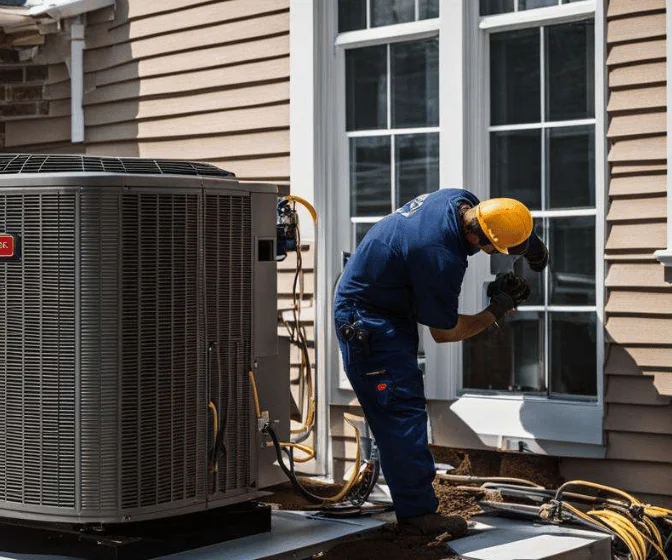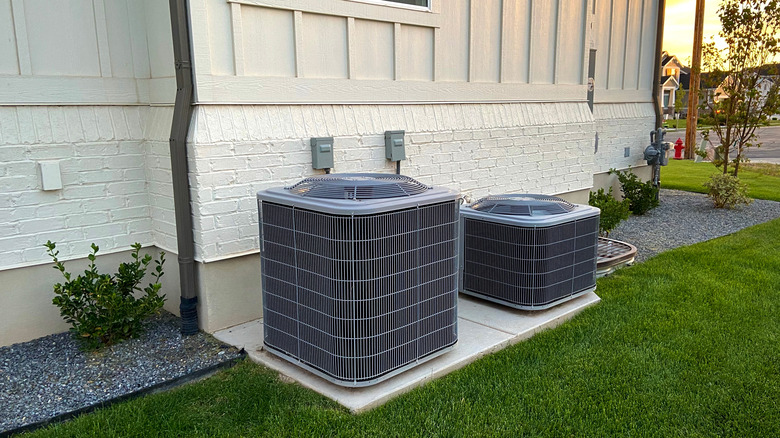Cost To Replace Central Air Conditioning

Replacing a central air conditioning system is a significant investment for any homeowner or facility manager. Understanding the factors that influence the cost, choosing the right system, and knowing the installation process are crucial for making an informed decision. This article provides a comprehensive overview of the costs associated with replacing central air conditioning, exploring various system types, efficiency ratings, and installation considerations.
Factors Influencing the Cost of Central Air Conditioning Replacement
The total cost of replacing a central air conditioning system is not simply the price of the unit itself. Several elements contribute to the final bill, including:
- System Size (BTU): The cooling capacity of an air conditioner is measured in British Thermal Units (BTUs). A larger home or building requires a higher BTU rating, resulting in a more expensive unit. An undersized unit will struggle to cool the space effectively, while an oversized unit can lead to short cycling and higher energy bills. Rule of thumb: For typical climates, estimate 20 BTU per square foot. For example, a 1,000 square foot home would ideally need a 20,000 BTU air conditioner.
- Efficiency Rating (SEER): The Seasonal Energy Efficiency Ratio (SEER) measures an air conditioner's cooling efficiency. Higher SEER ratings indicate better energy efficiency, translating to lower operating costs. However, units with higher SEER ratings generally have a higher upfront cost. The current minimum SEER rating mandated by the U.S. Department of Energy is 14 SEER in most regions. Some areas require even higher minimums.
- Type of System: Different types of central air conditioning systems have varying costs. Split systems (the most common type) have an outdoor condenser unit and an indoor air handler. Packaged units combine all components in a single outdoor unit. Ductless mini-split systems offer zone cooling and don't require ductwork.
- Ductwork: Existing ductwork may need to be modified or replaced to accommodate the new system, adding to the overall cost. Ductwork inspections are recommended to identify leaks or insulation issues that can reduce efficiency.
- Installation Labor: Labor costs vary depending on the complexity of the installation, the location, and the contractor's rates. Obtaining multiple quotes from licensed and insured HVAC contractors is essential.
- Permits and Inspections: Most municipalities require permits for HVAC installations. These permits ensure that the installation meets local building codes and safety standards.
- Additional Components: You might need to replace or upgrade related components such as the thermostat, electrical wiring, or circuit breaker.
Types of Central Air Conditioning Systems and Their Costs
Choosing the right type of central air conditioning system is crucial for balancing performance, efficiency, and cost. Here's a comparison of common system types:
Split Systems
Split systems are the most common type of central air conditioning. They consist of an outdoor condenser unit and an indoor air handler (often paired with a furnace). Advantages include relatively lower upfront cost, good energy efficiency, and easy maintenance. Disadvantages include the need for ductwork and potential issues with refrigerant leaks.
Cost Range: $3,000 - $7,000 (including installation). A 3-ton 16 SEER unit might cost around $4,500 installed.
Packaged Units
Packaged units combine all components (condenser, compressor, evaporator coil, and blower) into a single outdoor unit. They are often used in homes without basements or crawl spaces. Advantages include easier installation (compared to split systems) and space-saving design. Disadvantages include lower energy efficiency (typically) and higher noise levels (since the entire unit is outside).
Cost Range: $4,000 - $8,000 (including installation). A 3-ton 14 SEER packaged unit might cost around $5,500 installed.
Ductless Mini-Split Systems
Ductless mini-split systems consist of an outdoor condenser and one or more indoor air handlers mounted on walls or ceilings. They are ideal for homes without existing ductwork or for zone cooling specific areas. Advantages include energy efficiency, individual zone control, and easy installation. Disadvantages include higher upfront cost (per zone) and aesthetic considerations (indoor units are visible).
Cost Range: $3,000 - $8,000 per zone (including installation). A single-zone 18 SEER mini-split system might cost around $4,000 installed.
Understanding SEER Ratings and Energy Efficiency
The Seasonal Energy Efficiency Ratio (SEER) is a crucial factor to consider when choosing a central air conditioning system. It measures the cooling output of the system over a typical cooling season divided by the total electrical energy input during the same period. A higher SEER rating indicates better energy efficiency.
The U.S. Department of Energy (DOE) mandates minimum SEER ratings for new air conditioners. As of 2023, the minimum SEER rating is 14 in most parts of the country. Some regions, such as the Southwest, require a minimum of 15 SEER.
While higher SEER units have a higher upfront cost, they can save significant money on energy bills over the lifespan of the system. For example, upgrading from a 10 SEER unit to a 16 SEER unit can reduce energy consumption by up to 37%.
Consider the payback period when evaluating SEER ratings. A higher SEER unit might have a longer payback period, but it will ultimately provide greater long-term savings.
Installation Process and Considerations
Proper installation is crucial for ensuring the performance and longevity of your central air conditioning system. Here are some important considerations:
- Hire a Licensed and Insured HVAC Contractor: Always choose a reputable HVAC contractor with the necessary licenses and insurance. Check online reviews and ask for references.
- Proper Sizing: The contractor should perform a load calculation to determine the correct size of the air conditioner for your home. An oversized or undersized unit will not perform efficiently.
- Ductwork Inspection and Sealing: Inspect the existing ductwork for leaks or damage. Seal any leaks with duct sealant or replace damaged sections. Insulate the ductwork to improve energy efficiency.
- Refrigerant Charging: The contractor should properly charge the refrigerant according to the manufacturer's specifications. Incorrect refrigerant levels can reduce performance and damage the compressor.
- System Testing and Calibration: After installation, the contractor should test the system to ensure that it is operating correctly. Calibrate the thermostat and other controls for optimal performance.
- Permits and Inspections: Ensure that the contractor obtains the necessary permits and schedules inspections to comply with local building codes.
Cost Breakdown Example: Replacing a 3-Ton, 16 SEER Split System
Here's a hypothetical cost breakdown for replacing a 3-ton, 16 SEER split system in a typical single-family home:
- Equipment (Air Conditioner Unit): $2,500 - $3,500
- Installation Labor: $1,000 - $2,000
- Ductwork Modifications (if needed): $200 - $500
- Permits and Inspections: $100 - $300
- Thermostat Replacement: $100 - $200
- Total Estimated Cost: $3,900 - $6,500
Note: These are just estimates. Actual costs may vary depending on location, contractor rates, and specific project requirements.
Extending the Lifespan of Your Central Air Conditioning System
Proper maintenance can significantly extend the lifespan of your central air conditioning system and prevent costly repairs. Here are some essential maintenance tasks:
- Regular Filter Changes: Change the air filter every 1-3 months. A dirty filter restricts airflow and reduces efficiency.
- Coil Cleaning: Clean the outdoor condenser coil and the indoor evaporator coil annually. Dirty coils reduce heat transfer and increase energy consumption.
- Professional Maintenance: Schedule annual maintenance with a qualified HVAC technician. They can inspect the system, check refrigerant levels, and identify potential problems.
- Clear Debris: Keep the area around the outdoor condenser unit clear of debris such as leaves, grass clippings, and shrubs.
- Monitor Performance: Pay attention to any changes in the system's performance, such as reduced cooling, unusual noises, or increased energy bills.
Conclusion
Replacing a central air conditioning system is a significant investment that requires careful consideration. By understanding the factors that influence the cost, choosing the right system for your needs, and ensuring proper installation and maintenance, you can maximize your investment and enjoy years of reliable and efficient cooling. Remember to obtain multiple quotes from licensed HVAC contractors and thoroughly research your options before making a final decision. Investing in a high-efficiency system can significantly reduce your energy bills and improve your home's comfort for years to come.










